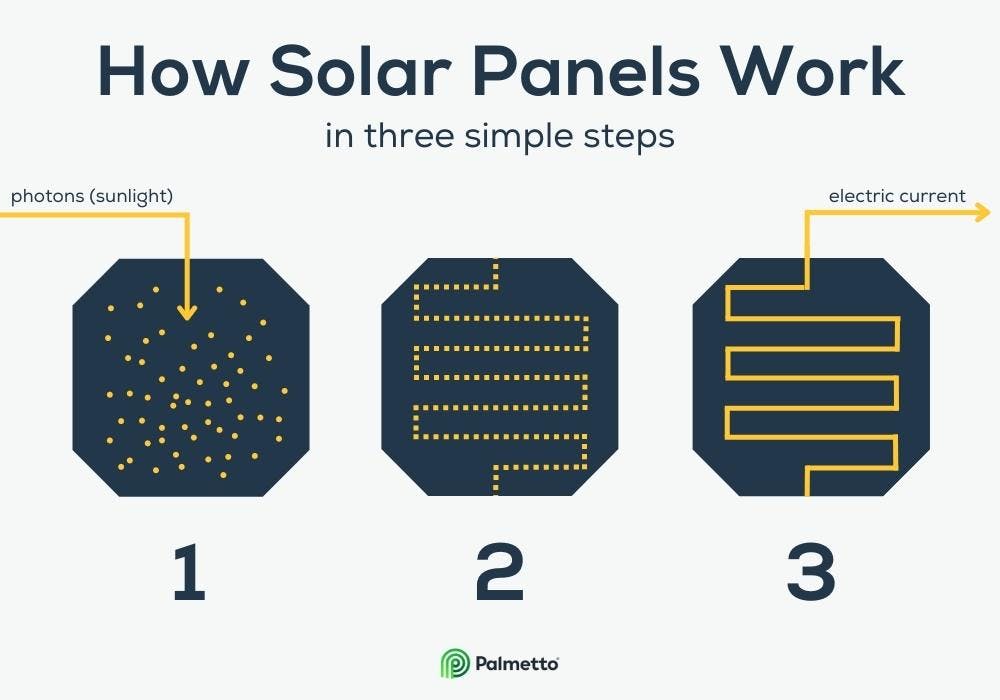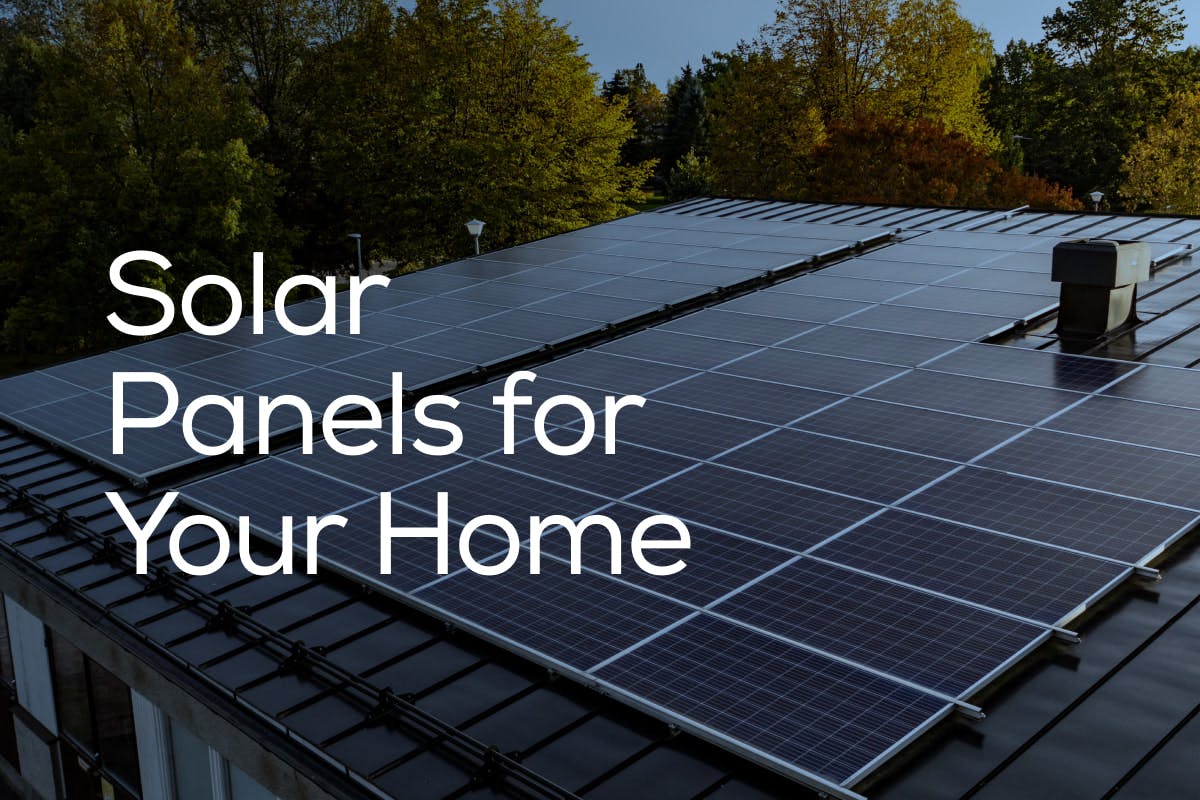If you’ve seen your neighbors install solar panels and wonder if they’ll work for you, you’ve probably got a few questions: What do solar panels cost? Will they save me money? How long do solar panels last? Are there ways I can reduce the cost of installing solar? And, how do solar panels actually work?
We’ve got answers to all those questions and more below.
See how much you can save by going solar with Palmetto
What Are Solar Panels?
Solar panels, also known as photovoltaic panels, convert light from the sun into electricity. When exposed to sunlight, electrons in the solar panel move around, and this movement can be harnessed as an electrical current, known as solar power or solar energy.
Since solar panels are powered by the sun, they don’t produce electricity at night. During the night, your home draws power from the electricity grid operated by your local utility company or from your battery storage system if you have one installed. Very few homes in the US are completely off-the-grid, even with solar power. It’s often too expensive.
How Solar Panels Work
The short answer is that materials within the solar panel, known as semiconductors, allow it to generate an electric current when exposed to sunlight. This is called the photovoltaic effect. It was first discovered in 1839 by Edmond Becquerel.
The process looks like this.
- Photovoltaic cells in the solar panels absorb energy from sunlight.
- The sun’s energy causes electrons to move around in the cells, creating direct current (DC) electricity.
- Wires capture that DC electricity from the surrounding cells and moves it out of the solar panel.

The amount of electricity solar panels produce from sunlight is referred to as solar efficiency. Most solar panels installed on homes have efficiency ratings over 20 percent.
Once the DC electricity has been captured, it is converted to alternating current (AC) electricity with the help of inverter technology. AC electricity, which is used by most home appliances and the wider grid, flows through the electrical panel and is distributed throughout the home to power electronic devices.
Any excess electricity produced by the solar panels is either stored in a battery or fed back into the electric grid.
Check out Explain Like I’m 5: Solar Panels for a simplified explanation of how solar panels work.
See how much you can save by going solar with Palmetto
How Can Solar Panels Save You Money?
Whether solar panels can save you money and how much comes down to the specifics of your home, your electricity bill, and local policy.
One way solar panels can save you money is by avoiding utility electricity. Just like growing your own vegetables can reduce your grocery bill, generating your own electricity can reduce your electric bill.
Depending on your state and utility policies, you may also be able to earn bill credits for the electricity you don’t use and send to the grid. Net metering and net billing policies can save you by offsetting some or all of the cost of the electricity you still need to buy from your utility (like at night).
In a few places, you might also be able to sell solar renewable energy certificates (or SRECs). Utilities and other entities that need to meet certain renewable energy requirements can buy SRECs to cover part of their obligation. In states with SREC markets, prices are set by supply and demand and can vary over time. Many SREC markets have seen declining prices in recent years.
Solar Panel Incentives
For many people, solar savings are only worth it if they’re greater than the cost of going solar. The good news is that solar panels are subject to national, and in some cases, state and local incentives that bring down the cost.
One of the most important and longstanding incentives is the federal solar tax credit, recently renamed the Residential Clean Energy Credit. It lets people who own qualifying solar panel systems to claim a tax credit worth 30% the cost of the system. The tax credit only counts against your tax liability but can be rolled over to future years and has no dollar amount limit. Since everyone’s tax situation is different, consult your tax advisor about your eligibility.
States may offer their own tax credits or exempt solar panels from state and property taxes. In some cases, you might be able to get a rebate from your state or utility for installing solar. Since policies vary by location and can change over time, confirm incentives are available in your area before moving forward. A reputable solar company will be able to help you identify incentives that might be open to you.
Paying for Solar Panels
Incentives can bring the price of solar down, making it easier to afford. The most common ways of going solar are paying in cash, getting a loan, and leasing or entering into a power purchase agreement.
Paying for your panels upfront is the most straightforward and can deliver the greatest savings, since you own the panels outright and avoid paying loan fees and interest.
Loans let you work toward owning your system with more manageable monthly payments. Thanks to the interest you’ll need to pay (especially in times of higher rates), your lifetime savings may be less than if you paid upfront, but many loan-financed systems save their owners money.
Third-party ownership describes leases and power purchase agreements, two ways to go solar without actually buying the system. Under a lease, you pay a monthly fee for the panels on your roof, which can reduce your electric bill with the electricity they generate. A power purchase agreement is similar, but you pay for the electricity the solar panels generate.
Palmetto’s LightReach Energy Plan lets you go solar and skip the upfront cost for predictable monthly payments. LightReach also has options to buy out your system starting in year five.
Types of Home Solar Power Systems
There are three types of home solar power systems: grid-tied, hybrid, and off-grid.
- Grid-tied: The most common system type, where rooftop solar panels produce DC power that is converted into AC power with the help of an inverter. The home remains connected (or tied) to the grid, and if your solar panels don’t produce enough electricity to power your home, you can draw extra power from the grid.
- Hybrid: Includes a battery that stores excess energy produced by solar panels. When the solar panels can’t provide all of the electricity a home needs, the home can either pull extra electricity from the battery or the grid. You can also charge your battery with grid power when it would be beneficial, such as taking advantage of time-of-use rates.
- Off-grid: A home that is not connected to the public electric grid, so all power needs must be met through solar panels, batteries, and other sources of self-generated power.
Pros and cons of solar panel system types
| Grid-tied (no battery) | Hybrid | Off-grid |
|---|---|---|
| Draw power from the grid | Draw power from the grid | Must provide all electricity for a house. |
| Can typically use net metering, if available | Can typically use net metering, if available | No net metering available |
| Avoid battery expenses | Battery storage is an additional expense | Probably requires a battery |
| Solar panels stop during a blackout | Can “island” during a blackout to keep parts of house powered | Unaffected by blackouts, but needs to supply all electricity for the house. |
Benefits of Solar Panels
Here are five main reasons why you should consider installing home solar panels.
- Provides clean, renewable energy: Solar energy produces no pollution, and generating electricity from the sun’s power is much better for the environment.
- Greater energy independence: When you produce your own electricity, you have more control over where your energy comes from, what you can do with it, and how much it costs. In addition, battery storage can help you avoid power outages and blackouts, which provides peace of mind during a storm.
- Savings on your electric bill: Because your solar panels can generate much of your home's electricity, you could reduce your utility bills.
- Tax incentives: The federal solar tax credit can help you with the upfront costs of the installation, and some states have similar solar incentives.
- Proven technology: Current solar panel technology will continue generating electricity for 25 years or more, and solar panels are built to withstand extreme weather conditions.
Solar Plus Storage
Solar panels are increasingly being installed with battery storage. While it represents an additional expense, battery storage provides a reassuring backup and, in some cases, increased savings. In 2023, approximately 12% of all distributed solar installations were paired with storage of some kind, according to the Solar Energy Industries Association. SEIA expects that number to be 28% by 2028.
Depending on the capacity of the installed battery and the electricity demand of the house, batteries can keep at least parts of a home powered up through an outage. In 2022, the average American utility customer experienced five and a half hours without power, according to the US Energy Information Administration.
Another potential benefit is increased savings. In places with weakened net metering policies, battery storage can be a way to avoid even more utility electricity and increase your savings. After California shifted to NEM 3.0, a net billing policy with smaller credits for electricity sent to the grid, 60% of solar installations had batteries, up from 10% before the shift.
See how much you can save by going solar with Palmetto
Solar Panel Maintenance
Solar panels can be low maintenance equipment, though you might want to clean your solar panels from time to time. When something does go wrong, it’s best left to a professional, as amateur tinkering can void warranties or create fire risks.
Be sure to review the warranties offered with your equipment and understand who is responsible for repairs. Some companies offer post-installation protection and maintenance plans with extended warranties, proactive monitoring, and speedier service, depending on your level.
3 Types of Solar Panels
There are three major types of solar panels: monocrystalline, polycrystalline, and thin-film. Both monocrystalline and polycrystalline panels are made from crystallized silicon, whereas thin-film panels are made of thin films of semiconductors deposited on glass, plastic, or metal.
Monocrystalline are by far the most common type of solar panel installed in residential settings.
Each type of panel has its unique attributes.
- Monocrystalline: The most efficient, high-performing panel you can install on your home. Its black color is aesthetically pleasing, but this panel type is typically the most expensive.
- Polycrystalline: Less efficient than monocrystalline, but costs less. They look blue, which some people find less appealing.
- Thin-film: The lowest performance efficiency of the three, but it’s more portable, lighter weight, and has greater aesthetic appeal. Thin-film panels are typically used in large-scale installations.
What Do Solar Panels Look Like?
You may have seen black and blue solar panels, and wondered what the difference is.
Monocrystalline panels are made of high-quality crystals. During the manufacturing process, silicon is formed into one large crystal, which appears black to the human eye. Most new residential solar installations use monocrystalline solar panels.
Polycrystalline panels are made of many smaller and separate crystals, and appear blue to the human eye. Thin-film solar panels are also black and do not vary in color.
The look of your solar panel installation will vary depending on how and where panels are arranged on your roof. They’re installed in a collection of multiple panels that generates electricity as a system called a solar array. The shape and design of your arrays can depend on the size of your roof, how shaded it is, and where the panels will produce the most electricity.
The number of solar panels you need also depends on many factors, including the size of your electricity bill, the physical location of the arrays, and the direction they face.
To get an idea of how solar panels could look on your roof (and what savings they might unlock) check out Palmetto's solar savings estimator or contact a solar advisor today.
See what solar can do for you:
Frequently Asked Questions
How do I start planning for a home solar power system?
Start by reviewing your electricity bills, and assess your needs based on your energy usage, the age and size of your roof, nearby shade trees, and more. You can get easy help from Palmetto’s free solar design and savings estimate tool.
How much do residential solar panel systems typically cost?
The exact solar panel cost and long-term savings of your system may vary depending on several factors.
- The size of your system
- Your energy usage
- Your electricity rates
- Any incentives in your area
- The size and layout of your roof
- Preference for cash or loan financing
How long does it take to install a residential solar power system?
The actual installation will only take a few days of work on average. However, getting to that stage can take weeks, and sometimes months, depending upon the financing for your panels, as well as the permitting and regulatory requirements of your city, county, and state governments. Watch our 3-step “Timeline to Solar Savings” video to learn more:
What is net metering?
Net metering is a solar incentive program where you can earn bill credits from your utility company if your solar panels produce more electricity than you use in your home, and feed that extra electricity back into the grid. You can then use those bill credits to cover the future cost of electricity you use from the grid.
Do solar panels require maintenance?
A: Solar panels require very little maintenance, as they are made of durable materials like tempered glass and aluminum, and have no moving parts. Most solar panel manufacturers include solar warranties of up to 25 years. However, panels do occasionally require service or maintenance to keep them operating at peak efficiency, as outlined in our solar power maintenance and service guide.
Can I install solar panels myself?
In limited cases you may be able to install solar panels yourself. If your panels are going to connect to the grid, you may not be legally allowed. Residential solar systems typically require permits and other paperwork, not to mention technical electrical work, that are best lest to professionals.
See what solar can do for you:
Disclaimer: This content is for educational purposes only. Palmetto does not provide tax, legal, or accounting advice. Please consult your own tax, legal, and accounting advisors.
 Andrew BlokWriter and Editor
Andrew BlokWriter and EditorAndrew has worked as a journalist and writer for four years, over half of those dedicated to covering solar. He currently lives in Tucson, AZ, where you might run into him walking his dog and birding while dodging the heat. He has degrees in English education and journalism.

